ANTARCTIC TRADE CARDS - SERIES 2
Launched: 29 August 2004. Last updated: 11 October 2007
NOTE: This is a continuation of the original section "Antarctic Trade Cards - Series 1". Cards in that section are numbered from 1 to 32. The Index below covers both series.
Click on the thumbnail photos to enlarge. Number in brackets is the catalogue number of cards in my collection. Information on cards not included would be very welcomed, so too information surrounding the issuance of these cards and related. At the end of this listing are cards for which I'm seeking more information.
--R. Stephenson
INDEX (Persons; Ships; Card issuer; Card series)
"Adventurers & Explorers" [Brooke Bond Oxo Ltd.]
037; 062; 065
"Aeroplane Series" [Wischmann's Picture Pack Gum]
032
American Tobacco Co.
040; 041
Amundsen, Roald
001.22; 041; 042; 060; 062; 075; 076; 077; 078; 079; 080; 081; 082; 089; 094; 095; 102; 104.6; 106
Anglo-American Chewing Gum Ltd. ('Vell Boy' Bubble Gum)
087; 088; 089
"Antarctic Adventure" [Sanitarium Health Food Company]
027; 028
"Antarctic Series" [Cadbury Bros. Ltd.]
003
"Australian Men of Stamina" [Stamina Self-supporting Trousers]
044
"Astrolabe"
029
Atkinson, Dr E.L.
001.17
C. Beriot
100
J. Bibby & Sons Ltd.
047
Birds Eye Foods Ltd.
012; 091
Borchgrevink, C.E.
085
Bowers, Lt H.R.
001.6; 002.5
"Britain's Maritime History" [John Player & Sons]
015
British American Tobacco Co. Ltd.
021; 024
Brooke Bond & Co. Ltd.
009
Brooke Bond Oxo Ltd.
013; 037; 053; 062; 065
"Builders of Empire" [J. Wix & Sons Ltd.]
097
"Builders of the British Empire" [J. A. Pattreiouex Ltd.]
020; 051
"Builders of the Empire" [W.D. & H.O. Wills Ltd.]
096
Byrd, Richard E.
032; 104.8; 104.10; 104.12
Cadbury Bros. Ltd.
003
Cadet Sweets
036
"James Caird"
022; 023; 066
Carreras Ltd.
006; 064; 092
"Celebrated Ships" [W.D. & H.O. Wills; The Imperial Tobacco Co of Great Britain and Ireland, Ltd.]
033; 063; 070
"Celebrities and their Autographs [Nicholas Sarony and Co.]
004; 019; 090
"Celebrities of British History" [Carreras Ltd.]
092
Charcot, Jean-Baptiste
046
Chocolat Aiguebelle
046
Chocolat Pupier
075
Chocolats Nestlé, "Cala" Peter, Cailler, Kohler.
076
Cigarette Oriental de Belgique
007
Captain James Cook
090; 091; 092
Côte d'Or chocolate
107; 110
De Gerlache, Adrien
099; 101
Demetri
001.9
"Devon Worthies" [James Pascall, Ltd.]
052
"Discovery"
006; 015; 053; 054; 083
Duncan & Co.
067
Drake, Francis
001.5
"Endurance"
039; 065; 104.5
"Erebus"
086; 098
Evans, E.R.G.R.
001.2; 001.16; 001.18; 002.4; 003.3; 003.4
Evans, P.O. Edgar
002.5
"Evolution of the Steamship" [Duncan & Co.]
067
"Exploration & Adventure" [Quaker Oats]
011
"Famous Boys" [Godfrey Phillips Ltd.]
056
"Famous Explorers" [Cadet Sweets]
036
"Famous Explorers" [F & J Smith Cigarettes]
050; 068
"Famous Feats"
023
"Famous Firsts"
060
"Famous Men Through the Ages" [Cigarette Oriental de Belgique]
007
"Famous People" [Brooke Bond & Co. Ltd.]
009
"Famous People" [J. Lyons & Co. Ltd.]
008
"Famous Ships" [R. & J. Hill Ltd.]
054; 059; 098
"Famous Ships" [D.C. Thomson & Co. Ltd.]
039; 048; 086
"Famous Ships in History" [Sanitarium Health Food Company]
016; 029; 083
"Famous Statues" [J. A. Pattreiouex Ltd.]
049
"Famous Voyages" [Ty.phoo Tea]
022
"Feats of Endurance" [Oxo Limited]
038; 069
"Fram"
058; 059; 061; 063; 077; 078; 079; 109
Fry's Pure Cocoa
002
Fuchs, Sir Vivian
031; 108
"Geschicte unserer Welt" [Fritz Homann AG]
102
"Great Achievements" [Typhoo Tea Ltd.]
031
"Great Britons" [Shell Oil]
010
Hassan Cork Tip Cigarettes (American Tobacco Co.)
040; 041; 085
Hignett Bros. & Co. (Branch of the Imperial Tobacco Co. (of Great Britain & Ireland), Ltd.
066
R. & J. Hill Ltd.
054; 059; 098
Hillary, Sir Edmund
108
Fritz Homann AG
095; 102
Kellogg Company of Great Britain Ltd.
060
La Cacao Poulain
093
"La Conquête du Pôle Sud"
104
J.F. Lehmann's Verlag München
0077; 078; 079; 080; 081; 082; 099
Liebig Meat Extract Company
025; 101
Lillie, Dennis
002.12
Lindström
001.23
J. Lyons & Co. Ltd.
008
Marr, Scout
056
Mawson, Sir Douglas
044
Meares, Cecil
002.23
"Men of Courage" [Anglo-American Chewing Gum Ltd. ('Vell Boy' Bubble Gum)]
088; 089
"Men of Progress" [Anglo-American Chewing Gum Ltd. ('Vell Boy' Bubble Gum)]
087;
"Men of Stamina" [Stamina Self-supporting Trousers]
042; 043; 044; 045
"Meteorology Series" [Shell Oil]
026
"New Zealand Treasury of the Years" [Sanitarium Health Food Company]
014; 017; 018
"Nimrod"
021; 030.13; 070
Nordenskjöld, Otto
100
"Notable Ships Past & Present" [Carreras Ltd.]
006; 064
Oates. L.E.G.
001.3; 001.8; 002.5; 002.19; 013; 014
Ogden's (Branch of the Imperial Tobacco Co. (of Great Britain & Ireland), Ltd.
066
"100 Years of Great British Achievements" [Typhoo Tea Ltd.]
108
Oxo Limited
038; 069
James Pascall, Ltd.
052
J. A. Pattreiouex Ltd.
020; 049; 051
John Player & Sons
001; 015; 030; 035
"Polar Exploration" [John Player & Sons]
001; 030
"Pourquoi Pas?"
046
Quaker Oats
011
"Queen Elizabeth I - Queen Elizabeth II" [Brooke Bond Oxo Ltd.]
013
"Quest"
024; 033; 055; 057; 064
Ross, Sir James Clark
096; 097; 104.3
"The Sage of Ships" [Brooke Bond Oxo Ltd.]
053
Sanitarium Health Food Company
014; 016; 017; 018; 027; 028; 029; 083; 105
Nicholas Sarony and Co.
004; 019; 090
Scott, Robert Falcon
001.1; 002.1; 002.5; 002.21; 002.24; 002.25; 003.1; 003.8; 003.9; 004; 005; 007; 008; 009; 010; 011; 012; 017; 036; 037; 045; 048; 049; 050; 051; 052; 084; 087; 103; 104.4; 104.7
"Sea Adventure" [Hignett Bros.& Co. (Branch of the Imperial Tobacco Co. (of Great Britain & Ireland), Ltd. and Ogden's (Branch of the Imperial Tobacco Co. (of Great Britain & Ireland), Ltd.]
066
Shackleton, Sir Ernest
019; 020; 022; 030.15; 030.16; 030.23; 030.24; 040; 043; 057; 064; 065; 066; 068; 069; 088; 093; 104.2; 104.9
Shell Oil
010; 026
"Ships and Shipping" [British American Tobacco Co. Ltd.]
021; 024
"Ships' Figureheads" [John Player & Sons]
035
"Ships of all Times" [United Tobacco Companies (South) Ltd. (South Africa)]
033; 057; 058
F & J Smith Cigarettes
050; 068
"Sports Records" [Turf Cigarettes]
005
Stamina Self-supporting Trousers
042; 043; 044; 045
Teofani & Co. Ltd.
034
"Terra Nova"
001.7; 002.13; 003.5; 003.10; 003.12; 016; 018; 033; 034; 035; 048; 067
"Terror"
098
"This Wonderful World" [J. Bibby & Sons Ltd.]
047
D.C. Thomson & Co. Ltd.
039; 048; 086
"Transport Then & Now" [Teofani & Co. Ltd.]
034
Trex Club
047
Turf Cigarettes
005
Typhoo Tea Ltd.
022; 031; 108
United Tobacco Companies (South) Ltd. (South Africa)
033; 057; 058
Echte Wagner Margarine
084
W.D. & H.O. Wills; The Imperial Tobacco Co of Great Britain and Ireland, Ltd.
033; 063; 070; 096
"The Wild South" [Sanitarium Health Food Company]
105
Wilson, Dr Edward A.
001.4; 002.5
Wischmann's Picture Pack Gum
032
Wisting, Oscar
001.25
"With Captain Scott at the South Pole" [Fry's Pure Cocoa]
002
J. Wix & Sons Ltd.
097
"Wonders of the Seven Seas" [Birds Eye Foods Ltd.]
012; 091
"The World's Greatest Explorers" [Hassan Cork Tip Cigarettes (American Tobacco Co.)]
040; 041
Yacht Cigarettes
055; 061
ADDITIONS SINCE ORIGINAL POSTING (SEE SERIES 1)
047. 7. THE ANTARCTIC. Issued to members of Trex Club by J. Bibby & Sons Ltd. (1955). Card number 7 from a set of 25 entitled "This Wonderful World".
Recto: View from within ice grotto with two men near entrance and ship in distance.
Verso: THIS WONDERFUL WORLD | (A Series of 25) 7. THE ANTARCTIC. | The Antarctic, the area round the South Pole, includes a continent of over 5,000,000 square miles, which is the size of Australia and Europe without Russia. Yet not one person lives there permanently, there is not a single land creature bigger than an insect, and only mosses and lichens--not one tree! But in the seas there are whales, seals, etc., as well as fish. And, of course, there are penguins. Here, too, is the famous Ross Barrier, the greatest floating ice sheet in the world, roughly the size of France. The seaward edge is 400 miles long. The thickness of the sheet varies from 500 to 1,500 ft. Our picture shows the entrance to a vast ice-cavern hollowed out by a warm current of sea-water. | Issued to members of the | TREX CLUB | by J. Bibby & sons Ltd., Liverpool 3
Note: Image and information courtesy of Evan Jones, Wiltshire, England.
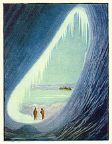
076. LA CONQUÊTE DU PÔLE NORD. Issued by Nestlé Chocolates. (Date?). Card number 9 from Series No. 39 of an unknown number. Size: Ca. 2.25" x 1.57".
Recto: View of Amundsen standing in profile in polar clothing holding a pair of skiis. Also tent and a second figure. At bottom: SERIE 39 No 9.
Verso: CHOCOLATS | NESTLÉ, "CALA" [or GALLA] PETER, CAILLER, KOHLER | ALBUM NESTLÉ | SPORTS -- CONTES -- EXPLORATIONS | Serie No 39 | La Conquête du Pôle Nord | F Timbre No 9 | Amundsen | Cette imager fait partie d'une très jollie collection contenuedans un bel {?} album en vente chez votre ?? de chocolat. [Printing is faint in places]
Note: Image and information courtesy of Evan Jones, Wiltshire, England.
Further Note: "These (076 and 104) both come from the same Nestle chocolate album: Album Nestle 1935-1936 Sports, Contes, Explorations.
Series 39—La Conquete du Pole Nord—consists of 12 cards, of which no.9 is Amundsen.
Series 40—La Conquete du Pole Sud—consists of 12 cards, which are as listed on your site.
As well as these, Nestle also produced another 12 cards, in their next album: Album Nestle 1936-1937 Sports, Contes, Explorations, Paysages de France.
Series 62 - Expedition Byrd au Pole Sud
1. Admiral Byrd
2. Debarquement des avions sur la Grande Barriere
3. Attelages des chiens pour le transport du materiel
4. Construction d'un hangar d'avion en blocs de neige
5. Petite Amerique: Quartier General de l'expedition
6. Transport du materiel par autochenilles
7. Cabine de radio au camp
8. Avions prets au depart
9. Depart de Byrd pour le Pole
10. A 4,500m au-dessus de la chaine de la Reine Maud
11. Survol du Pole Sud
12. Retour au quartier general"
See also 104 below.
Source: John Edwards

NOTE: Cards 077 through 082 are from a set of 12. These are described as "labels", an example being lot 1424 of Classic Stamps Ltd (New Zealand) Sale Number 37, November 2004. The catalog entry reads: "See page 26 in Goldberg's 'Expedition Mail..." book. This is Roald Amundsen Expedition Mail Letters Postcards & Stamps by Fred Goldberg, 2000. It was "...meant to be an exhibition catalogue for the special exhibit to be opened in the Fram museum on the 4th of May 2000 to commemorate the 75th anniversary of the flight attemps towards the North Pole and the return of the Maud from its last three years in the ice."
The 12 labels are illustrated on page 26 of the catalogue and each is identified by a letter (a-l) which is given with each entry below [eg. 'Goldberg CI3.1a']. The series is described on page 25 thusly: "C13.1 In Germany a set of 12 vignettes having the size of a regular stamp has been made. They are printed with strong colours and show pictures from different stages of the expedition. All vignettes have the text "Roald Amundsen zum Südpol". On the lower corners is marked "KVNST". These vignettes were probably issued shortly after the expedition took place."
Aubrey Halpern, a UK philatelist, e-mails to say: "A definition of a label is very wide; it cannot be used for postage and it is usually produced as a commercial item such as to raise money for an expedition or sometimes to advertise a product such as Jam. After the Scott and Amundsen expeditions quite a lot of what are called Poster Stamps were issued with lots of them having Antarctic connections such as penguins."
Mr Halpern kindly provided scans of those labels I originally was lacking. These have been added after the original entries and are numbers 082a through 082f, this being necessary in order to avoid renumbering all subsequent cards.
104. LA CONQUÊTE DU PÔLE SUD. Issued by ? in Serie 40 of 12 cards. In this instance, the cards are mounted on two pages of text in French (not included here, other than the card titles). Size: Ca. 2.2" x 1.57".
Recto: Various scenes. At lower left: Serie 40. At lower right: Card number [1-12].
Verso: Unknown as these are mounted in an album. The titles below are printed on the album pages.
Note: Image and information courtesy of Evan Jones, Wiltshire, England.
Further Note: "These (076 and 104) both come from the same Nestle chocolate album: Album Nestle 1935-1936 Sports, Contes, Explorations.
Series 39—La Conquete du Pole Nord—consists of 12 cards, of which no.9 is Amundsen.
Series 40—La Conquete du Pole Sud—consists of 12 cards, which are as listed on your site.
As well as these, Nestle also produced another 12 cards, in their next album: Album Nestle 1936-1937 Sports, Contes, Explorations, Paysages de France.
Series 62 - Expedition Byrd au Pole Sud
1. Admiral Byrd
2. Debarquement des avions sur la Grande Barriere
3. Attelages des chiens pour le transport du materiel
4. Construction d'un hangar d'avion en blocs de neige
5. Petite Amerique: Quartier General de l'expedition
6. Transport du materiel par autochenilles
7. Cabine de radio au camp
8. Avions prets au depart
9. Depart de Byrd pour le Pole
10. A 4,500m au-dessus de la chaine de la Reine Maud
11. Survol du Pole Sud
12. Retour au quartier general"
See also 076 above.
Source: John Edwards
104.1 No 1 - Otaries des mers du Sud.
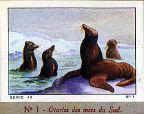
104.2 No 2 - L'angoisse de Shackleton.
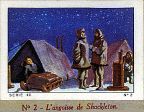
104.3 No 3 - Ross.

104.4 No 4 - Scott.

104.5 No 5 - La fin de l'Endurance.
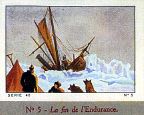
104.6 No 6 - Amundsen et ses compagnons
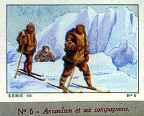
104.7 No 7 - La fin de Scott.
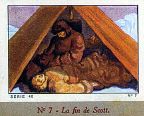
104.8 No 8 - L'avion de Byrd.
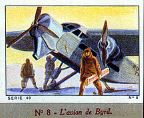
104.9 No 9 - Shackleton.

104.10 No 10 - Byrd.

104.11 No 11 - La grande nuit polaire.
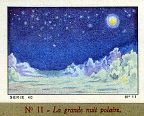
104.12 No 12 - Byrd, au Pôle Sud, lance les drapeaux.

105. THE WILD SOUTH. Issued by Sanitarium Health Food Company, Auckland, New Zealand. (1986) A set of 20 cards of which 6 are Antarctic related. Size: Ca 2.85" x 2.25".
Recto: Color photographs of various Antarctic subjects (6 of the 20 cards), as listed below.
Verso: Typical text: One of a set of 20 cards | WILD SOUTH | Card No. 1 | ADELIE PENGUIN | This most lovable and numerous of Antarctic penguins, the Adeliecross the vast expanse of sea ice every year in their millions, returning to the same breeding spot and mate as the year before. Incubation of hte eggs is shared equally, and loyalty to their mates and chicks is of the greatest importance. |
Published in 1986 by | SANITARIUM HEALTH FOOD COMPANY | PRIVATE BAG, AUCKLAND | © BCNZ ENTERPRISES | SWAPS: To obtain a full set of 20 cards, swap with your friends or post to us one card for any card you need (stating its number) and you must enclose a stamped addressed envelope. | PLACE YOUR CARDS IN 'THE WILD SOUTH' CARD ALBUM AVAILABLE FROM YOUR FOOD STORE.
[5242]

Main text from remaining cards:
No. 3 Rockhopper Penguins. Quarrelsome Rockhopper Penguins live on the cold Antipodes Islands. Their fiery red eyes are signs of a blazing temper, andthough small, they make up for their size with a loud voice. Their major enemy is the hungry Skua. And there is a threat of overfishing and depleting their food supply.
No. 5 Royal Albatross. Clumsy on land, the Royal Albatross is a picture of elegance in the air. They breed on several islands including Enderby Island. Chicks fly after eight months, and breed after seven or eight years. Their strange tube-noses expel excess salt taken from their seafood diet.
No. 8 Hooker Sea Lion. Each summer, many of the world's 5000 Hooker Sea Lions gather at Enderby Island, south of New Zealand. The males appear first, waiting for the females to arrive and have the pups they have borne for a year, before mating again. Sea Lions are good mothers, but less-than-interested fathers. Hookers are the rarest Sea Lions in the world, and feed mainly on squid.
No. 10 Skua. Although its hackles and bent bill are eagle-like, the rest of the Skua is all gull. It nests close to other seabirds, living in cunning and piracy, stealing eggs from careless penguins on beaches, the young and weak rabbits on the hills behind, and cleaning up any refuse in Seal, Sea Lion and Penguin breeding colonies.
No. 14 Fur Seal. Found throughouit much of New Zealand, Fur Seals were once hunted for the soft brown fur under its coarse hair. In 1978 an Act of Parliament made them full protected. Well camouflaged, they play in the surf and rest on rocks. They feed mainly on the plentiful squid. Seals attack if cornered so they're best viewed from afar. At present they are increasing in numbers.
107. ANTARCTIC. Issued by Côte d'Or chocolate. (Date? Relates to the 1963-66 Belgian Antarctic Expedition). Unnumbered card from a set of unknown number. Size: 6" x 4"?.
Recto: Three photographs: Sno-cat, 2 ships and a penguin scene. Text at bottom reads: SPECIMEN DER VERZAMELING "ANTARCTIC" VERBRUIKERS DER Côte d'Or PAKKEN versiert het prachtig album "ANTARCTIC". De chocolade en de suikerwaren Côte d'Or zijn produkton welke door het Wereldinstituut voor de Bescherming der Hoge Heedanighied van de Voeding gewaarborgd zijn. [There may be minor errors in transcription as lettering is small.]
Verso: Unknown.
Note: Image courtesy of Aubrey Halpern, UK.
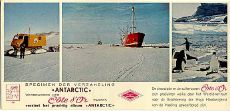
110. ANTARCTIC. Issued by Côte d'Or chocolate. (1959. Relates to the 1959 Belgian Antarctic Expedition). The set includes a total of 164 cards. Size: ca. 3" x 2".
Recto: Photographs without captions.
Verso: Unknown.

OTHER ANTARCTIC SUBJECTS
025. LIEBIG. Six colored Antarctic views. Issued in 1936 in German, French, Italian, Spanish and perhaps other languages. The Liebig Meat Extract Company was founded in 1868 and produced more than 2000 tradecard sets, up to 1962. Approximate size: 4.35" x 2.78:.
[4549]

025.1
Recto: Color view of penguins on shore with island in distance. Title below: L'Antarctique. | 1) L'Ile de Cockburn | Produits Liebig: force et saveur de la viande. | [Facsimile signature in lower right corner] | Reproduction interdite. | Explication au verso.
Verso: Absolument pure, la Graisse Liebig rancit moins vite, parce qu' exempte dleau. Frire à la Graisse Liebig, c'est frire hygiéniquement.
1) L'Ile de Cockburn.
Les régions polaires arctiques ont été explorées bien avant les régions antarctiques. Il faut attribuer cela à 1'é1oignement considérable de ces contrées de tout centre civilisé. L'hémisphère sud de notre globe contient en effet beaucoup moins de terre ferme que L'hémisphère nord, et son exploration systématique n'a commencé qu'à partir de la seconde moitié du 18è siècle. Les noms de Cook, Weddell, Dumont d'Urville, Ross, Larsen, de Gerlache, Scott, Shackleton, Wilkins & Byrd resteront toujours attachés à cette émouvante épopée.
Si nous prenons le 60è parallèle sud comme limite, il n'y a aucun être humain à demeure dans l'antarctique, tandis que dans le Nord on trouve au-delà de ce paralèle une grande partie de la presqu'ile scandinave, de la Russie, de la Sibérie, tout l'Alaska et tout le Groënland. C'est vous dire que l'Antarctique est le pays de Ia désolation.
Notre vignette vous montre I'le de Cockburn, comme elle est vue à partir de l'ile de Seymour. Ces terres se trouvent à la latitude correspondant à celle de la ville de Drontjem en Norvège. Elles se trouvent dans la mer de Weddell sont volcaniques et ne portent que de très rares traces de végétation. Les seuls habitants sont les pingouins, ces curieux oiseaux plongeurs, vivant en bandes et formant de véritables sociétés.
D'ici, le capitaine Larsen a rapporté en 1892 une multitude de fossiles. Actuellement cette région est activement exploitée par les baleiniers. Pour mieux vous orienter, nous sommes ici au Sud de Ia Terre de Feu.
025.2
Recto: Color view of large iceberg. Title below: L'Antarctique. | 2) Icebergs dans la mer de Wddell.--Phoques Weddell. | Véritable Extrait de Viande Liebig. | [Facsimile signature in lower right corner] | Reproduction interdite. | Explication au verso.
Verso: De l'avis des médecins les viandes grillées sont plus digestibles et par conséquent les plus nutritives. C'est parce qu'elles ont conservé tout leur suc, leur jus, en quelque sorte ce qui fait Ia valeur du Liebig très justement appelé: "Le meilleur de Ia viande".
2) Icebergs dans la mer de Weddell. Phoques Weddell.
Dans cette même mer de Weddell, flottent des icebergs de dimensions et de formes impressionnantes. Et dire que ce que l'on voit au-dessus de l'eau n'est que le dixième de Ia masse! Pour chaque mètre de hauteur que l'on voit, il y a sous eau neuf mètres de glace! Les icebergs sont des blocs, détachés de Ia gigantesque calotte polaire, et qui flottent au gré des vents et des courants, fondant lentement au fur et à mesure qu'ils voyagent vers les régions tempérées. Ils constituent un grand danger pour la navigation. Le naufrage du grand transatlantique "Titanic" était dû à une collision avec un iceberg.
Si l'on excepte les pingouins et quelques insectes, on peut dire que pas un animal terrestre n'habite les terres antarctiques.
Les phoques sont des animaux marins, qui viennent se reposer soit à terre, soit sur des glaçons flottants. Vous en voyez ici quelques spécimens. En hiver, ils restent sous la glace, et entretiennent eux-mêmes des ouvertures, afin de pouvoir régulièrement venir respirer à la surface.
La tempéature ]a plus basse qu'on ait enregistrée est -- 77° Fahrenheit, c'est à dire que nos thermométres centigrades marqueraient -- 61°.
Compagnie Liebig, fondée en 1865.
025.3
Recto: Color view of Mounts Erebus and Terror with elephant seals on ice floes in the foreground. Title below: L'Antarctique. | 4) Le Glacier du Diable. | Produits Liebig:améliorent la cuisine. | [Facsimile signature in lower right corner] | Reproduction interdite. | Explication au verso.
Verso: C'est signé Liebig: c'est une garantie. Le Bouillon OXO est un
produit Liebig. Une ou deux cuillerées à café OXO suffisent pour
bonifier les mets, pour corser le goût des 1égumes fades, pour
renforcer les sauces faibles. Avec OXO on obtient, sans viande, de savoureux potages et sauces.
3) Les Volcans Erebus et Terror. -- Eléphants de mer.
Alors que les îles Seymour et Cockburn se trouvent au sud de la Terre de Feu, I'île de Ross, appartenant à la Terre de Victoria, est située au sud de la Nouvelle Zélande, mais beaucoup plus près du Pôle que les deux premières.
Pour s'orienter autour du Pô1e Sud, on a supposé quatre quadrants de 90°, avec le méridien de Greenwich comme point de départ. Ce sont en allant de l'Ouest à l'Est les quadrants Gauss, Victoria, Ross et Weddell. Seymour et Cockburn se trouvent dans le quadrant Weddell, et l'île de Ross dans le quadrant Victoria, tout au fond de la mer Ross, à la limite de la Barrière de Glace. Cette île est très volcanique. Elle est constituée par quatre volcans et sa plus grande largeur est 80 Km. Ross a nommé les deux principaux volcans Erebus et Terror, noms des deux navires de sa flotte. L'Erebus a 4000 m. de hauteur et était en activité lors de sa découverte en 1841. Le Terror est moins élevé et son flanc oriental (Cap Crozier) sert de point d'appui à la Barrière de Glace.
Les animaux à l'avant-plan sont des mammifères marins, des éléphants de mer, ainsi nommés à cause de la forme spéciale de leur lèvre supérieure, allongée en forme de trompe.
025.4
Recto: Color view snow and ice landscape with sledgers. Title below: L'Antarctique. | 4) Le Glacier du Diable. | Produits Liebig:améliorent la cuisine. | [Facsimile signature in lower right corner] | Reproduction interdite. | Explication au verso.
Verso: Ne demandez pas simplement des Cubes, mais dites des Cubes OXO. Ils contiennent de I'Extrait Liebig. C'est pour cela qu'ils donnent un bouillon de viande de toute bonne qualité à meilleur compte.
4) Le Glacier du Diable.
La terre ferme autour du Pô1e Sud, le continent antarctique, a une surface plus grande que celle de l'Europe. C'est un bouclier rocheux, avec deux grandes mers en forme de golfes, la mer d Weddell et la mer de Ross, s'enfonqçant vers le Pôle. Et dans ces rochers on a trouvé des restes de plantes de hêtres et de fouèes, p. ex., qui certainement n'ont pu vivre dans ce climat. Afors on doit choisir entre deux hypothèses: ou bien, l'axe de Ia terre s'est déplacé, ou bien le continent a changé de place, a glissé par rapport au pôle. Les documents sont rares, à cause de l'"inlandsis", cette calotte de neige et de glace qui recouvre toute l'étendue de la terre polaire.
Notre vignette vous donne une idée de ces glaciers immenses, constamment en marche vers la mer ouverte, s'écoulant lentement comme des glaciers des Alpes, se crevassant, se brisant. Ils constituent de véritables fleuves de glace, et déversent le trop-plein à la vitesse de quelques mètres par mois.
La glace peut atteindre une épaisseur immense, allant jusqu'à plusieurs centaines de mètres. Ce qu'on appelle la Barrière, est la limite de la glace, un mur qui n'est pas toujours le bord de l'inlandsis, mais peut être un faux rivage, une masse énorme de glace, flottant librement.
La moitié droite de Ia vignette donne un aspect de Barrière.
Compagnie Liebig, fondée en 1865.
025.5
Recto: Color view of rocky headland with ice below. Title below: L'Antarctique. | 5) Le Cap Penard à la Courbe des Flandres. | Cubes de Bouillon, marques Oxo et Liebig. | [Facsimile signature in lower right corner] | Reproduction interdite. | Explication au verso.
Verso: L'Utile et l'agréable sont réunis dans les Cubes de Bouillon Liebig à l'Extrait Liebig, qui permettent de préparer instantanément un litre de délicieux bouillon à l'arome de viande et de légumes frais.
5) Le Cap Penard à la Courbe des Flandres.
En 1897, le Belge Adrien de Gerlache explora une partie du quadrant Weddell (secteur Sud-Américain), notamment la côte ouest de la Terre de Graham et y découvrit de grandes îles: Brabant et Anvers, séparées de la terre ferme par le Canal de Gerlache. A cet endroit la terre ferme porte le nom de côte Danco, du nom d'un participant à l'expédition.
Notre vignette vous montre l'aspect de la côte dans ces parages, aspect surprenant par la forme des rochers.
Les roches contenant des fossiles ne sont pas si anciennes que celles-ci. Les roches ici représeutées sont aussi anciennes que le granite, le gneiss et le porphyre: c'est du basalte. Tout ce groupe est d'origine éruptive. Le basalte est coloré par de l'oxyde de fer, une espèce de rouille.
L'aspect général de ces montagnes et leur composition géologique sont en tous points comparables aux Andes. Cela suggèe l'idée que ces massifs ne sont que la continuation, l'aboutissement de l'énorme arête qui traverse du nord au sud les deux Améiques. Aussi l'expédition de Gerlache a-t-elle proposé pour ces montagnes le nom, de "Antarctandes" c.-à-d. les "Andes de l'Antarctique".
Compagnie Liebig, fondée en 1865.
025.6
Recto: Color view of of Cape Crozier with mountains in the background. Title below: L'Antarctique. | 6) Morcellement de la glace au Cap Crozier. | Bouillion Oxo, consommé concentré en flacons. | [Facsimile signature in lower right corner] | Reproduction interdite. | Explication au verso.
Verso: La vie est chère pour celles qui ne savent pas utiliser au mieux les ressources, de l'art culinaire. Si vous voulez faire une cuisine meilleure bien que moins coûteuse, employez sans hésiter l'Extrait de Viande Liebig qui, sous une forme concentrée, contient la force et la saveur de la meilleure viande de boeuf. Depuls près de 3/4 de siècle, les bonnes ménagères en ont fait leur profit.
6) Morcellement de la glace au Cap Crozier.
Cette dernière vignette nous montre l'extrémité orientale de I'île de Ross, le cap Crozier dont nous avons déjà parlé.
L'iniandsis de l'Antarctique est sept fois plus étendu que celui du Nord et forme un grand plateau. De la calotte émergent, aux environs du Pô1e Sud même, les Monts de la Reine Maud. Dans la mer de Ross, cet inlandsis forme la Barrière entre la terre de Victoria et ]a terre Edouard VII. Cette Barrière a 850 Km. de long et s'avance en mer de 1 m. par jour. Finalement l'extrémité antérieure se rompt, et forme une masse flottant librement.
On a rencontré dans l'Atlantique Sud de ces blocs immenses, ayant jusque 70 Km. de front, ce qui les fait prendre pour de la terre ferme.
Cette série de vignettes nous montre d'une manière frappante que ces terres méritent bien le nom de Pays de ]a Désolation. Malgré cela, l'homme, toujours avide de savoir, ne s'est pas découragé. Faisant front aux menaces de ce pays ingrat, poussé par sa curiosité insatiable et dans le but d'être utile à la science, il a bravé tous les dangers, et a remporté la victoire.
026. ANTARCTIC WEATHER STATION. Issued by Shell Oil in Australia (1963). It is card number 414 from a set of 60 cards (#361-420) entitled "Meteorology Series". The front of the card shows an artist-drawn representation of an Antarctic Weather Station, while the back of the card has a descriptive text. The card was given as a free premium with purchase of petrol.
Recto: View of meteorological station with various equipment and one figure. Title upper left: Antarctic Weather Station.
Verso: Unknown.

027. ANTARCTIC ADVENTURE. Issued as a set of 30 cards by Sanitarium Health Food Company, Auckland, New Zealand (1972). Size: 2.85" x 2.25".
Recto: Color photographs of various Antarctic subjects, as listed below.
Verso: Typical text: One of a set of 30 cards | ANTARCTIC ADVENTURE | No. 1 Memorial Cross, Cape Evans | This Memorial was erected in 1917 by the survivors of Shackleton's Ross Sea Party of his Transantarctic Expedition 1914-1917, to the memory of three of their companions who lost their lives. Lieut. A. E. Mackintosh R.N.R. and V. G. Hayward perished on the sea ice in a blizzard in May, 1916; and the Rev. A. P. Spencer Smith died on 9th March, 1916. | Published in 1972 by | SANITARIUM HEALTH FOOD COMPANY | PRIVATE BAG, AUCKLAND | SWAPS: To obtain a full set of 30 cards swap with your friends; or post us one card for any card you need (stating its number) and enclose a stamped addressed envelope. | PLACE CARDS IN "ANTARCTIC ADVENTURE" CARD | ALBUM -- 20c FROM YOUR FOOD STORE.
[4875]
Main text from remaining cards:
No. 2 Scott's Hutt [sic], Cape Evans. Scott's Hut at Cape Evans is the most historic site in Antarctica. Established in 1911 for his journey to the South Pole, the hut is 50 feet long and 25 feet wide. It was later used by the Ross Sea party of Shackleton's Trans-Antarctic Expedition in 1915-1916. It was fully restored to its original condition by a team from New Zealand in 1960-1961.
No. 3 Kitchen at Scott's Hutt [sic]. A party of New Zealanders cleared ice from Scott's Hut in 1960-1961 and carefully restored it to the condition it was when Scott left on his fatal journey in 1911. The kitchen has the original stove, utensils and supplies, Scott's bed and some personal belongings - a pipe, a pouch, an ink pot - still remain.
No. 4 Scott Base in Summer. Scott Base was erected in January, 1957 and first occupied in 1957-1958 by the New Zealand component of the Trans-Antarctic Expedition. A well equipped laboratory provides facilities required for undertaking the following continuous programmes: seismology, geomagnetism, ionospheric physics, auroral and airglow, radio propagation, satellite tracking and meteorology.
No. 5 Scott Base, in moonlight. New Zealand's Antarctic establishment, Scott Base, is close to Mt. Erebus, a 13,000 foot active volcano. Our expeditions are organised and operated by the Antarctic Division of the Department of Scientific and Industrial Research. Antarctica's ice sheet covers five million square miles and rises to over 10,000 feet, in the interior of the continent.
No. 6 Icebergs, Moubray Bay. Icebergs are formed by the breaking away of large sections of the great ice barriers, or from the tongues of glaciers protruding into the sea. The largest ones resemble floating islands, many miles in circumference while the smallest are just chunks of ice. Icebergs have been sighted as far north as latitude 60 degrees south, but by this time they are usually in an advanced state of decay.
No. 7 Decaying Iceberg, Cape Hallett. A drifting iceberg has only one-sixth of its bulk above water. Sometimes they are driven by wind and currents close to the land, where they become grounded. Under the influence of weather a process of decay sets in. This often gives rise to spectacular and beautiful formations.
No. 8 Ice Cave Scott Base. Ice, in all its forms, rules Antarctica. This cave near Scott Base is formed by a snowfield cornice which has folded over and down until it has touched the sea ice at the foot of a concave hillside. There are winding tunnels, spacious galleries hung with hoar crystals and deep cracks in the clear, blue floor. The ice moves and creaks audibly.
No. 9 Aurora. The Antarctic sky can be a spotless blue or a mass of fiery reds and yellows and, on winters nights the Aurora Australis, (or Southern Lights) a shimmering curtain of beautiful colours is sometimes seen. This is caused by inter-action between the earth's magnetic field and charged particles from the sun in the ionosphere 50 to 100 miles above the earth.
No. 10 Ice Cave. Movement of the Ross Ice Shelf against Ross Island causes the formation of pressure ridges in the ice. The continual pressure causes the formation of cavities large enough for men to explore. The icecaves are lit by a blue green light filtering through the ice above and providing an eerie but beautiful colouring.
No. 11 Drift Snow and Camp at Polar Plateau. While much of the scientific recording work in Antarctica is done from permanent bases, field camps are used for surveying, mapping and exploratory work. This one is on the Polar Plateau, 6,000 feet high, at the head of the Davis Glacier. The camps are moved in by air, and from these the men use motor toboggans to make short trips of exploration.
No. 12 Emperor Penguin, Cape Crozier. The Emperor is the largest of all penguins, standing nearly four feet tall and weighing up to 80 pounds.
He is well marked by a golden orange necklace, hence the name "Emperor". The chick of this superb bird is quite drab by comparison, resembling a grey bundle
of fluff. The Emperor is the only Antarctic bird that rears its young in the darkness of the winter night.
No. 13 Adelie Penguins. Birds, seals and whales are the only natural inhabitants of Antarctica. The most common bird is the Adelie Penguin. They are fully grown at about 18 inches high and weigh about 14 pounds. They live on fish and other sea life. These birds breed in immense numbers in their Antarctic rookeries in October and and they return to their winter home on pack ice in March.
No. 14 Weddell Seal Pup. The Weddell seal is a true creature of the Antarctic. It lives close to the land throughout the year, keeping its breathing holes in the sea ice open by gnawing through with its strong teeth. The cows deposit their fast growing pups on the shore in November and they "baa" like lambs. McMurdo Sound has a population of several thousand and many live around Scott Base.
No. 15 Sea Elephant. Following near extinction during the old sealing days, seals are now protected through international agreement and their numbers are increasing. The Sea Elephant usually breeds on the Sub-Antarctic Islands but small rookeries are found on the northern shores of the Antarctic continent. Sea Elephants are agressive and the bull will fight fiercely to protect his herd of females.
No. 16 South Pole. The United States established this communications and weather recording station right at the South Pole in December, 1956. Captain James Cook first discovered Antarctica in 1773-1775. British explorer Ernest Shackleton reached within 100 miles of the South Pole in 1908-1909 and the first man there was a Norwegian, Roald Amunsden on 14th December, 1911. Englishman Robert Falcon Scott and four companions reached the Pole a month later but all died through food shortage and extreme cold on their way back to base.
No. 17 Vostok. Vostok is an inland Antarctic Station of the U.S.S.R. The 18 months from July, 1957 to December, 1958 were set aside for scientists to work together and take observations in order to improve their understanding of the earth and its changes. Twelve nations set up stations in land around the continent from which to explore Antarctica, earth's least known area. Much data was gained and exchanged between countries and the work is still continuing.
No. 18 McMurdo Winter. At the South Pole the sun disappears below the horizon for six months, but at the United States McMurdo Station, 840 miles north, the winter lasts four months. There is evidence to show that the continent is "warming-up" and temperatures in summer near the coast may rise above zero. However, coastal temperatures in winter plunge to -50°C and it drops to more than 100 below zero in the interior. Base facilities include this church, a hospital and post office.
No. 19 Taking sample of lake bottom. These men are taking a sample of the bottom of a frozen lake through the ice. Antarctica has been set aside as an international reserve for scientific reseatch. Total land area is twice the size of the U.S.A. Ice is an average of 6,000 feet thick. The only plant life is in the icefree areas around the coasts where lichens and mosses grow.
No. 20 Branding Seals. Branding seals and learning about their habits and environment is one of the tasks undertaken by men of the Antarctic to find and record all information of the coldest continent. There are four species of Antarctic seal--the crabeater seal, leopard seal, the rare Ross seal and the Weddell seal. Crabeater seals feed on krill, Ross seals on squid, leopard seals on penguins and other seals and Weddell seals on fish.
No. 21 Surveying with Theodolite. A surveyor's work in Antarctica is difficult and dangerous. In setting up his theodolite to take levels, the handling of the knobs and screws can be painful. Gloves must be worn, for if the bare hand touches metal the skin sticks to it and the hand can be moved only by tearing off a layer of skin. As a result of the work of these devoted New Zealanders, the Ross Dependency has been accurately mapped.
No. 22 Taking reading at Met. Screen. Meteorologists have discovered much about Antarctic weather and conditions that affect us in New Zealand. Antarctic weather is the world's fiercest. The high central South Pole Plateau in the middle of Antarctica is the coldest place on earth--minus 125 degrees F. The sun does not appear for six months of the year and, while it shines in "summer" the temperature still hovers around zero.
No 23 The Ross Dependency Post Office. It provides full postal and communications facilities for men working permanently at and around the base and for the influx of visitors in the summer months. Ross Dependency stamps are issued. The base was erected in 1957, on Ross Island, for International Geophysical Year scientists, and has been manned permanently every year since by parties from New Zealand.
No. 24 Scott Base Mess. While outdoor conditions at Scott Base can be unpleasant, the men working there today live under very modern conditions compared to those of the early explorers. This is their mess, or "dining room". It is part of a complex of nine solidly constructed huts, linked by a covered way. Auxiliary buildings include two magnetic huts, two seismology huts, an auroral tower and a hangar.
No. 25 Dominion Range, Blue Ice. A dog-hauled sled is pictured on the blue ice of the Dominion Range at the head of the Beardmore Glacier. The great continent is not altogether white--there are areas of amazing colours in brilliant surfaces from violet, emerald and cobalt coloured depths. Antarctic is not silent either--blizzards howl and shriek and terrifying noises come from the moving ice.
No. 26 Vehicles used at Scott Base. Most vehicles used in Antarctica are developed specially for the cold conditions. Transport at Scott Base is provided by seven type of vehicle--from a Landrover with sand tyred wheels to big tracked vehicles, and, of course, motorised toboggans. The tracks are extra wide to prevent sinking into the snow. New Zealand still has some dogs but they are not now used as extensively as in earlier years.
No. 27 Helicopter. Helicopters have become the workhorses of Antarctica. They support field parties and small summer stations within a 100-mile radius of their base. Their versatility has been largely responsible for the successful exploration of difficult access areas such as the dry valleys of Victoria Land. The first man to fly an aircraft in Antarctica was Sir Hubert Wilkins, of Britain, in 1928. Admiral Richard E. Byrd of the United States made the first flight over the South Pole in November, 1929.
No. 28 Icebreaker, U.S. Eastwind. The icebreaker has perhaps done more than any other machine to make large scale Antarctic exploration possible. United States Navy icebreakers can cut channels through ice up to 15 feet thick through which cargo ships can follow. In spring Operation Deep Freeze icebreakers break up to 50 or 60 miles of channel in McMurdo Sound to allow in the first cargo convoy.
No. 29 Supply Ship. Captain Robert Falcon Scott spent his first two Antarctic winters "frozen in" in his little wooden ship "Discovery". Today the icebreakers make it easy for supply ships to take food, fuel and equipment to the bases. The icebreakers cut a channel through the thick ice and the thinner-hulled cargo ships follow.
No. 30 R.N.Z.A.F. Hercules at McMurdo. Flying from the United States air base at Christchurch Airport, the huge Constellation and Hercules aircraft
carry stores, men and heavy equipment, such as ground vehicles, quickly to Antarctic bases. The Hercules is ski-equipped and is invaluable in conveying geological and survey parties to remote areas of the vast continent.

028. ANTARCTIC ADVENTURE. Issued by Sanitarium Health Food Co. (probably for Weetabix, although not noted as such) (1985) in a series of 20. Unclear whether these were issued in Australia or New Zealand (not noted). Size: 2.9" x 2.15".
Recto: Color photographs of various Antarctic subjects, as listed below. Blue border with narrow white rule separating view.
Verso: Typical text: ANTARCTIC | ADVENTURE [in blue ink with view of penguins and sailing ship] | Card No. 1 | Approaching Antarctica, the pack-ice closes in. Anchoring is simple for small ships. Just secure the boat to a floe. | A colour project poster is obtainable from your local food stores or by sending a 33-cent stamp to the nearest Sanitarium Office (addresses on the top of the pack). SWAP with friends or post us one card for any card you need (stating its number) enclosing a stamped, addressed envelope. To attach the card to your Antarctic Adventure poster, use either tape or collector's stamp hinges - available from your newsagent. [The text referring to the poster appears on each card. The poster is 425 x 600mm in size.]
[5211]
Main text from remaining cards:
No. 2 As the pack-ice inscreases, it's hard to find a channel. Because the ice is continually shifting, it's necessary to watch for fresh openings, then sail through.
No. 3 One of the huge Emperor penguins sayshello. Penguins fish from the coastal fringe of the continent. Emperors dive deep - up to 46 metres.
No. 4 A scientist fishes for specimens of local marine life. Notice the background rocks. Even in Antarctica, the land sometimes shows through.
No. 5 A ridge forms in the ice where two great sheets press together, highlighted by the last rays of the autumn sun. Winter in this region is one long night or twilight, sometimes brightened by the moon or stars.
No. 6 Frozen specimens of Antarctic fish. Ninety per cent of the region's deepwater fish are found nowhere else in the world. Fish from other regions could not stand the freezing water.
No. 7 Observing the wind speed. Antarctica is battered by raging blizzards, sometimes strong enough to toss tractors through the air. And when a blizzard begins, it can continue for weeks. If you lean against the wind and it drops - you can fall flat on your face.
No. 8 Here's 'the tip of an iceberg' Icebergs form by breaking off the edge of the glaciers on the mainland. Note the huge glacier in the background of this shot.
No. 9 Weddell seals can live under huge sheets of ice by cutting holes in the surface with their teeth. Here a seal, in the foreground, has come up to breathe. Behind, scientists record the 'song' of the seals with a microphone suspended in the water under the ice.
No. 10 Sheltering from a 112 km/h wind on the ice-covered sea. If something goes wrong with the tent, food, clothes or heating, you can quickly die. The margin of safety in Antarctica is very slim indeed.
No. 11 The birth of an iceberg. This huge chunk has just broken off the glacier behind it ... and is slowly turning over. Notice how smooth it is on the side that has been underwater. Ice is still falling down its face.
No. 12 Once, dogs pulled the sleds. Now, there's the snowmobile. Here, one has jammed the rig in rough ice. This kind of problem can happen many times a day.
No. 13 The conditions near the South Pole often cause strange lighting effects. These are 'sun dogs', a natural refraction phenomenon.
No. 14 The hardy birds of the Antarctic have amazing endurance. Penguins spend their lives on ice or in freezing water. One Stormy Petrel was found 16,093 km from where it had been tagged. It had flown across the pole and half-way round the world ... in just two months.
No. 15 An Emperor penguin chick huddles under its father's belly. These huge birds hatch their eggs by balancing them on their fur-covered feet with a warm flap of skin above them, like a rug. And, when chicks feel cold, they crawl right back there.
No. 16 Trying to catch a smaller penguin for checking. It's not really fond of the idea. Penguins cannot fly. But they swim like seals and can be found right around the Antarctic coastline. They could not survive inland because they depend on the sea for food.
No. 17 Collecting mosses and lichens. The only plant life on the continent is this simple kind. How could big plants survive screaming blizzards and months without sunlight?
No. 18 A small ship chugs through thick and rotten ice. When the bow rises high enough on the ice, the weight of the ship breaks through. Notice the clear channel behind it.
No. 19 A natural arch in the ice. Notice the man standing beneath it? And the huge icebergs in the background? Any ship that anchored in this sunny cove would soon be crushed by the grinding bergs.
No. 20 Two adventurers pulling sleds. This is called 'man-hauling'. They are trudging through boot-deep snow over sea-ice. The ridge in the background could be the shore.
[Showing only Card Nos. 5 and 14.]

030. POLAR EXPLORATION. Issued in a series of 25 by John Player & Sons in its "Polar Exploration" series (Date? Post 1909 but prior to Scott's death.). Size: 2.62" x 1.4".
Recto: Chromolithographic images from both north and south polar regions. Title is given at one end of the card and "Player's Cigarettes" appears at the opposite end.
Verso (typical): A SERIES OF 25 | POLAR EXPLORATION | [card number] | [Title and Description] | Issued by the | JOHN PLAYER & SONS | Branch of the Imperial Tobacco Co. | (of Great Britain & Ireland), Ltd. | Nottingham.
[4205]
Main text and image description from Antarctic cards (13-18; 23-25); Arctic cards (1-12; 19-22) only title given:
1. Andrée's Polar Balloon.
2. Dr. Fridtjof Nansen, G.C.V.O., F.R.G.S.
3. How Icebergs are Formed.
4. The Aurora Borealis.
5. Parry and Hoppner's Arctic Expedition.
6. Eskimo with Dog Sledge.
7. Ross and Parry's Expedition, 1818.
8. Commander James Ross at the North Magnetic Pole, 1831.
9. Peary's Arctic Expedition, 1898-1902.
10. Eskimo with their Toupiks or Summer Tents.
11. Eskimo Hunting Seal in a Kayak.
12. Relics of the Franklin Expedition.
13. The "Nimrod" picking up the Northern Party. Early in 1909, the Northern Party of the Shackleton Expedition returned from the South Magnetic Pole, and were encamped on the Drygalski Glacier. Their position was a trying one. While discussing the alternatives of a long wait on the glacier or a tedious and dangerous sledge journey, they were overjoyed to hear the ship's guns. On Feb. 4th, 1909, they were picked up by the Nimrod.
14. A Remarkable Fumarole in the Old Crater of Mount Erebus. A fumarole, or volcanic vapour well, is unsually detected by the thin vapour column issuing from it. In Antarctic regions, however, the cold freezes the vapour as it reaches the surface. Thus there are built up round the orifices ice-mounds which are often of peculiar shape. One observed by the Shackleton Expedition, 1907-9, was in the form of a couchant lion.
15. Start of the Western Party from Cape Royds. Shackleton's Antarctic Expedition, 1907-9. The Expedition wintered at Cape Royds, Ross Island, fifteen miles from Mount Erebus, an active volcano 13,000 feet high. On Dec. 1st, 1908, the Western Party left the winter quarters for the first time, to convey stores to the Northern Party on its return from the South Magnetic Pole. During a second journey the Ferrar Glacier was explored.
16. The Northern Party at the South Magnetic Pole. The Northern Party, sent by Lieut. Shackleton to the Magnetic Pole, was in charge of Prof. Edgeworth David, F.R.S., of Sydney University. They left winter quarters in Sept. 1908. On Saturday, Jan. 16th, 1909, they reached the calculated position of the Pole--72° 25'S. latitude, and 155° 16' E. longitude. The Union Jack was hoisted, and the surrounding country formally added to the British Empire.
17. The Ferrar Glacier. The Western Party of the Shackleton Expedition camped at the foot of this glacier on Dec 4th, 1908. On Dec. 15th the ascent was commenced, Christmas Day being spent on the glacier at an altitude of 2,470 feet. A geological survey of the glacier was made by the scientists who accomapanied the expedition.
18. The Aurora Australis. The phenomenon, so well known in the northern hemisphjere as the Northern Lights, or Aurora Borealis, also occurs in the Antarctic regions, where it is known as the Aurora Australis. Many brilliant displays were recorded by the Shackleton Expedition, 1907-9. Curtain aurora of the type illustrated were frequent at Cape Royds.
19. The Discovery of Greenland.
20. Sir John Franklin's Arctic Expedition, 1819-22.
21. Cabot's Voyage in Search of a North-West Passage, 1497.
22. Henry Hudson Cast Adrift.
23. An Extract from Sir Ernest Shackleton's Diary, Jan. 4th, 1909. Our illustration shows a page of the explorer's diary, written at a latitude between 87° and 88° S. Here, at an altitude of 11,200 feet, the cold was intense, the temperature at night being -24° Fahr. Five days after the extract was written, on Jan. 9th, 1909, the expedition reached a latitude of 88° 23' S., the farthest south ever attained. On January 10th the return journey commenced.
24. Lieut. Sir E. H. Shackleton, C.V.O. Lieut. Sir Ernest Henry Shackleton, son of Henry Shackleton, M.D., was born in 1869, and educated at Dulwich College. He commanded the British Antarctic Expedition, 1907-9. With this expedition the explorer reached a latitude of 88° 23' S., thus planting the British flag 100 miles nearer to either Pole than had previously been atained. In 1909 Lieut. Shackleton was made a C.V.O., and received the honour of knighthood.
25. The British Antarctic Expedition, 1910. A motor-sleigh tractor. On Wednesday, June 1st, 1910, there set sail from London the expedition which will, it is hoped, nail the Union Jack to the South Pole. The Commander, Captain Robert F. Scott, R.N., is relying for purposes of traction on motor-sleighs of the type illustrated. They are fitted with 4-cyl. vertical motors, and the chain-wheels drive an endless chain designed to grip in the snow and ice.

CONTINUED IN SERIES 2
CARDS THAT MAY BE OUT THERE--FURTHER INFORMATION WELCOMED
--In a recent online catalogue from Explorer Books (No 39, Summer 2005) two cards were offered that do not appear above. Here are the descriptions:
55. DUMONT D'URVILLE, Jules S-C. Advertising trade card for "High life Tailor, 17 Rue Faubourg Montmartre". Imp. Mazerand a Ccirey S.I.V., [Paris: c.1906]. £12
Coloured card portrait of Dumont d'Urville, 1790-1842, with background illustration of French vessel under sail and French seaman. Reverse with description of High Life Tailor, apparently an English business with premises in Paris. Size approx. 2 3/4" x 4". Very Attractive card in Very Good condition. Uncommon.
146. SHACKLETON, Lieutenant. Advertising trade card for Meurisse chocolates, titled "Lieutenant Shackleton. Expedition au Pole Sud 1907-1908. Chocolat Meurisse. Anvers". "Serie 5519:S" printed in margin. n.p., n.p.:[c.1910]. £30
Coloured card depicting Shackleton, on skis, with members of his party driving the ski-fitted motor car, and a group of ponies, with an inset highly-stylised portrait of Shackleton in uniform. Reverse with list of prizes awarded to Meurisse Chocolates. Size approx. 2 1Ú2" x 4". Very Good condition. Uncommon copy of a Very attractive card.


















